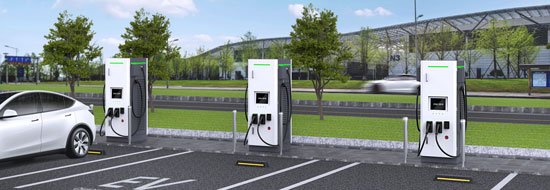When I met Keith and Melissa Silva at this year’s King of the Hammers race in dusty Johnson Valley, California, they had just five days to go before their Tesla-powered Chevrolet truck rig would compete in one of America’s most brutal off-road competitions. There was just one minor challenge: the truck wouldn’t go into reverse.
Five minutes later, Keith got it sorted out with a method that’s a cross between classic car-enthusiast elbow grease and “unplug the router.” “I did the same thing I always do,” he told me. “Just kick it in the ass and do a calibration update and boop, it goes back to normal.”

Such are the fixes when you take the battery and motor from a Tesla Model S and shove them into an old Chevrolet S10 rock crawler, all with little to no knowledge of EVs, wiring or computer software. Just turn it off and turn it back on again.
And yet it worked, proving for the second year that the Silvas may be onto something here.
King Of The Huh?
King of the Hammers takes place every January on Means Dry Lake bed in Johnson Valley, California. Over two weeks the event sees multiple races in some of the gnarliest terrain on the planet with competitors on motorcycles, UTVs, stock Jeeps, rock crawlers with 40-inch tires, and in the Silvas’ case, one nasty retrofitted Chevy truck.
Running as No. 2412, the Silvas’ rig has an 85 kWh battery pack while a single electric motor produces 416 horsepower and 443 pound-feet of torque. Even compared to the monster V8s that also compete, the TesTen—a combination of Tesla and S10—is a pokey little puppy. Still, the Silvas have an advantage with that instant electric torque delivery.

They have also installed a two-speed transfer case to keep the motor from generating too much heat trying to lay all that torque down at once. Beefy 37-inch Mickey Thompson tires and long travel suspension round out the package.
To be clear, the Silvas aren’t necessarily EV fanatics. They just love the sport of rock crawling and they enjoy a challenge. They aren’t in it for environmental reasons.
“Nothing about this truly is eco-friendly,” said Melissa. “We’re using a generator to charge the truck. We just have instant torque. We have instant power. There are so many pros.”
That instant power delivery is definitely an advantage at the Every Man Challenge, a one-day race meant for grassroots competitors. This race consists of a 73-mile high-speed desert loop and one shorter loop through the nastiest rocks you’ve ever seen. Whatever size rocks you’re thinking of, double it. These boulders are the size of a compact car. There are sheer drop-offs of six feet or more, steep climbs and competitors routinely flip over or drive over each other in order to reach the top. This is not a race for the faint of heart.

However, there is a touch of green sensibilities at King of the Hammers. Optima Batteries hosted over 50 EVs at the Optima Oasis, taking the Rivians, Teslas and Ford Lightnings out on curated trail runs. When it came time for them to charge, Optima’s parent company Clarios partnered with Renewable Innovations to bring off-grid charging up to 180 kW to the Oasis, powered by “green” hydrogen. More than 100 hybrids and EVs took advantage of the chargers they had onhand, the company said; all of it indicates there’s more of a future for electric off-roading than people think.
It’s still no easy path. Just ask the Silvas. The couple attempted the race last year but were unable to finish without running their battery too low, risking major damage. Their goal this year was to finish their desert lap and they spent all year making sure #2412 was up to the task.

And They’re Off
The TesTen was the 162nd car off the line and within a few miles encountered two easy-ish rocky hill climbs. Here the rig somehow managed to slip into high gear in the rear but low gear in the front. With the rear wheels wanting to oversteer and the front wheels hopping at each turn, Keith furiously jammed the selectors until they decided to behave.
The team took the first 37 miles at a slow but steady clip, coming into their first pit with 25% or so left in their battery. Now it would be time to wait.

While it’s possible to get a high-speed charge in the middle of the desert—remember Renewable Innovations was doing it at the Optima Oasis—the Silvas were on their own for charging solutions. Besides that, the TesTen can’t accept a Level 3 charge as it lacks the computer bits and bops to communicate with a high-speed charger. So the team installed a 6 kW onboard charger and let a 9,500-watt Harbor Freight generator do the job.
After four hours, some food and a quick snooze, the husband and wife team were charged to 75% and ready for the next 36 miles of desert terrain.

Fortunately, the remaining miles passed without much incident. The battery management system got confused a few times and turned the rig off for safety, but it easily started back up again. Towards the end of the race the drivetrain disconnected from the motor and they were barreling down a steep rocky path essentially in neutral before Keith managed to shove it back in through the gear selectors.
When they crossed the finish line the first thing out of my mouth was, “Holy shit, they did it.” Although they didn’t complete the rock section and official results have them as a Did Not Finish, the race organization had given the okay for their shorter lap. They realized their personal goal of completing the desert lap and went home with a trophy to boot.

When the dust cleared the team ran the numbers and figured they got 1.15 miles/kWh. It might seem that average is good enough to complete one 73-mile lap on a single charge, but the Silvas care about battery health. They don’t want to charge to 100% or run it down to zero.
For perspective, I’ve had the Hummer EV out in Johnson Valley and wasn’t able to get more than 1 mile/kWh of efficiency, but I’ve achieved better in the Rivian R1T in the dirt. However, the Silvas’ efficiency is pretty impressive when you consider the size of the tires and their air pressure as well as the terrain. And the fact that this is, essentially, a homebrew effort.
If It Was Easy, Everyone Would Do It
The Silvas put in countless hours in the garage and tens of thousands of dollars of their own money to make the TesTen a reality. Along the way, through YouTube videos, the generous donation of knowledge and products by folks from AEM and Radial Dynamics as well as plenty of trial and error, the TesTen is making off-road history.

For King of the Hammers 2025, the team hopes to be able to source another battery and swap them out at the pits. The truck is already set up for swapping with quick-connect cables and Keith says they can do it in 10 or 15 minutes. Multiple pre-charged batteries would give them the range to complete the entire Every Man Challenge, hopefully attracting more EV competitors and opening up a whole new class of racing.
“We want to be able to push the truck harder and try to keep up with the pack and not run out of range by the time we get the rocks,” Keith said. “We’ve got a lot of R&D still to do. But I mean, baby steps. It’s all new.”
[ad_2]
Source link




